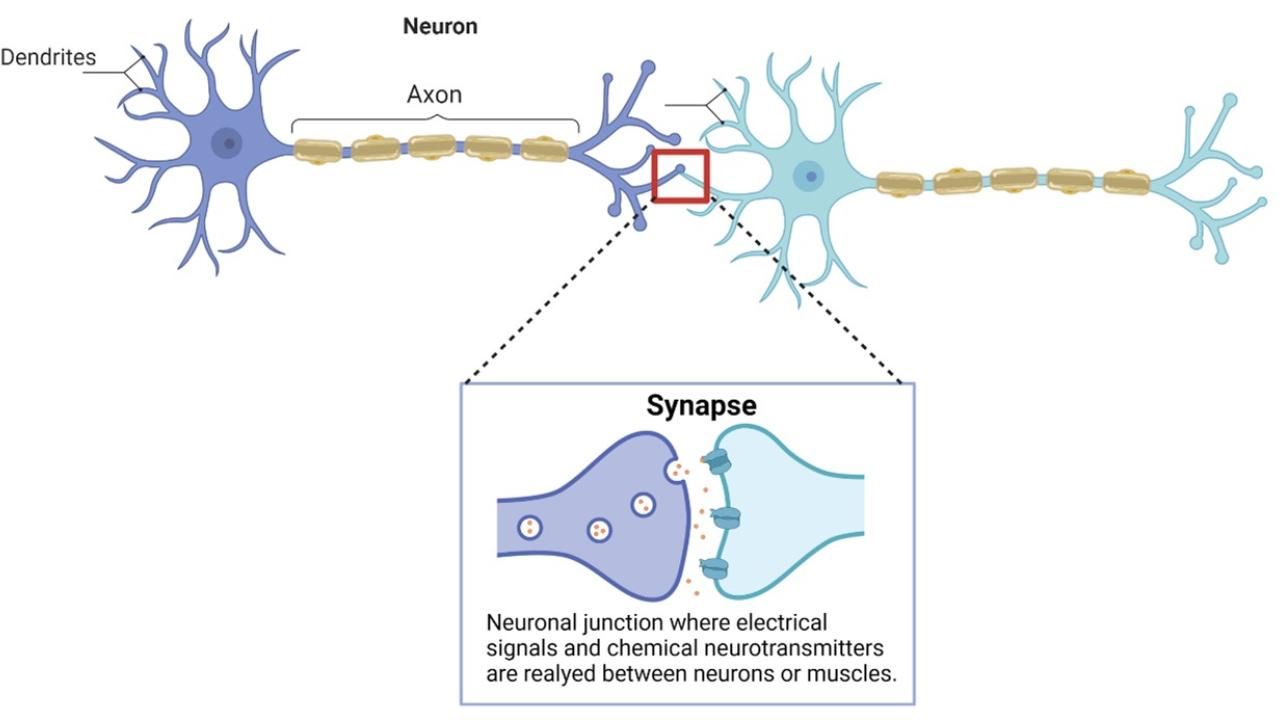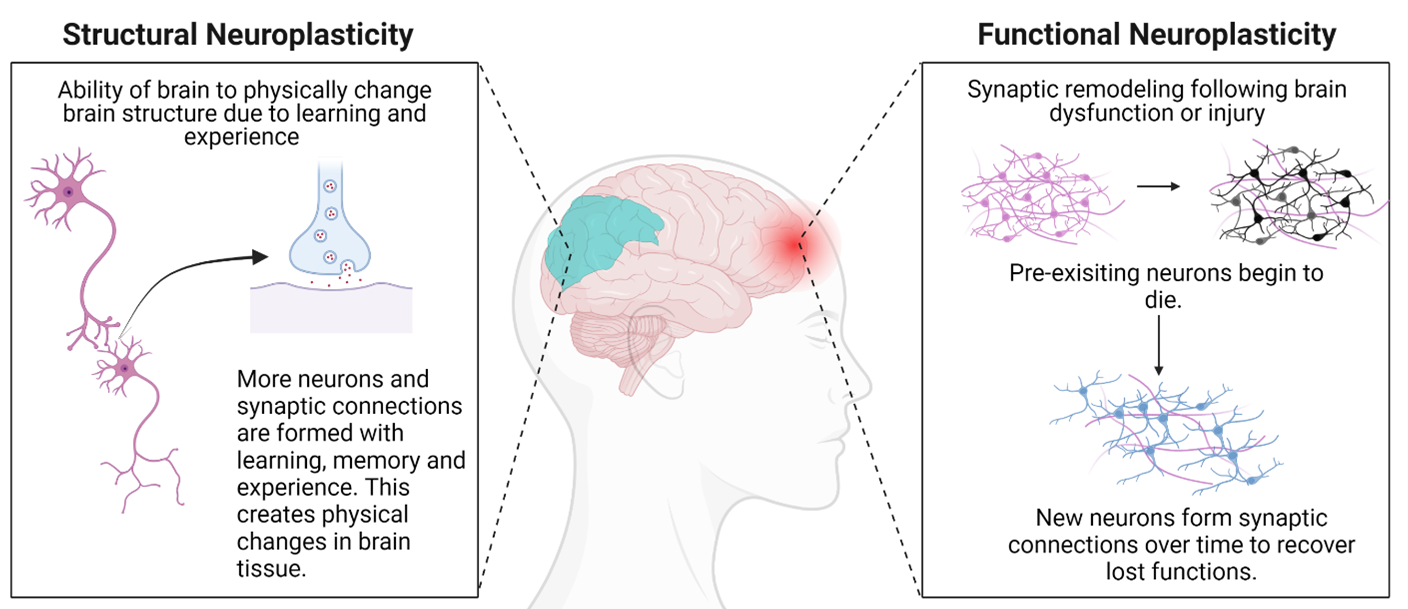
Neuroplasticity
How the Brain has a Mind of Its Own
The brain is a complex organ that controls every physical movement we have or ever will make and houses our sense of self. As merely on average 3-pound organ, the brain is somehow able to govern all our sensory input coming from sight, smell, touch, taste, and hearing and assemble messages in a way that directs our thoughts, speech, movement, and internal organ functions.
When you look at the anatomy of the brain, it can be, at the simplest, broken down into three sections: cerebrum, cerebellum, and brainstem. The cerebrum is the largest part of the brain and is further composed of different lobes (frontal, parietal, occipital, and temporal) that controls higher level functions and thinking, such as personality, speech, vision, touch, and memory. The cerebellum, often referred to as the “little brain,” controls muscle coordination and maintains posture and balance. Finally, the brainstem is the bridge between the cerebrum and cerebellum and controls the more automatic functions of life that we usually are never aware of. For example, the brainstem controls breathing, heart rate, digestions, sleep cycles, and other normal bodily functions.
Connecting all these functions are neurons, which are your brain cells that transmit information to each other and to the rest of the body. This interconnectedness is critical for the brain to change and adapt in response to experience in a phenomenon known as neuroplasticity. In fact, you could almost say that the brain has a mind of its own (pun intended).

At its simplest, neuroplasticity begins with the production of new nerve cells in a process known as neurogenesis. Each neuron then develops synapses that are connections with other nerve cells to send or receive electrochemical signals. As neurons form more connections and become part of more complex networks, they reorganize themselves in clumps of different densities that adjust as needed to allow for the completion of repeated tasks or respond to other typical environmental stimuli. Neurons are not the only cells involved in plasticity. Glial and vascular cells, other types of cells present in the brain, also play important roles in aiding learning and memory formation.
Neuroplasticity is often categorized into two types: structural neuroplasticity and functional neuroplasticity.

Figure 2 Neuroplasticity is popularly categorized into two categories: structural and functional. Structural neuroplasticity refers to physical brain tissue remodeling in response to learning and new experiences whereas functional neuroplasticity occurs when existing neurons propagate and form new synaptic connections after functional loss following injury. Image created with Biorender.com.
Structural Plasticity
Structural plasticity is the ability of the brain to alter its neuronal connections. This is considered to be a normal bodily process where new neurons are grown and forms synaptic connections with existing neuronal networks. This often commonly seen in during infancy and childhood, where the brain experiences rapid growth in number of neurons and synaptic connections as a result of learning, experience, and memory formation. When a baby learns to walk or talk for example, the brain adapts to this information by creating new neural pathways. At birth, each neuron in the cerebrum contains about 2,500 synapses and increases to about 15,000 synapses per neuron by age three as more experience and knowledge is gained. This rapid adaptability is why children are often able to learn new tasks and gain new abilities, such as language, technical skills, or bodily movements, more quickly and easily. We lose neuroplasticity as we grow older. In fact, adults are actually found to have about half the number of synapses as children. This is because we lose synapses that are not used often, in a process known as synaptic pruning.
However, this is not to say that neuroplasticity is lost altogether. Though much more limited, scientists have observed neuronal rewiring mainly in the hippocampus and olfactory bulb which is responsible for memory storage and sense of smell. Mechelli, et al., found that adults who learn a second language have increased gray matter density and the level of density is correlated with the fluency attained and the age at which the language was learned. But, if the language is not spoken often even after being learned, the synapses get pruned away and may be lost forever.
Functional Neuroplasticity
Functional neuroplasticity is the ability of the brain to alter the functional properties of its neurons. In other words, this type of plasticity occurs when the brain adapts part of its functions to compensate for malfunction or damage of neurons in another part of the brain. This is most often seen in cases of injury or other types of brain dysfunction. A popular example would be when an individual is born without hearing but other senses, such as hearing or touch, are magnified instead when their auditory cortex become used for processing touch or sight. Neuroplasticity also comes in handy in cases of brain damage, such as strokes. In a stroke, vessels in the brain either become obstructed or rupture, which inhibits oxygen and nutrients from reaching brain tissue. This can quickly cause tissue death and loss of cerebral functions. With neuroplasticity, healthy parts of the brain can adapt and take over the functions. Scientists believe some of this adaptability may be due to “dormant” synapses that are only become activated following injury and begin to fire again in an attempt to restore lost function.
This injury does not necessarily need to be physical in nature. Neuroplasticity has also been associated brain development after mental trauma. In many cases, especially following childhood trauma, the brain attempts to “protect” itself by altering connections to the amygdala and hippocampus, which control the fear response and memory storage, respectively. This can result in visceral, uncontrolled responses to perceived danger or sudden flashbacks and panic attacks when encountering a familiar stimulus. Neuroplasticity can also play a role in healing from trauma. Clinical neuroscientists and psychologists recommend individuals with trauma to use the brain’s innate plasticity to change trauma-induced behaviors to purposeful learned actions. For example, if there is a trauma-induced fear of spiders, purposefully change your reaction from instant fear into telling yourself that you can and will make a choice in how to handle the situation in a way that makes you safe. This idea of mindfulness, when consistently practiced, can change neural patterns by diverting the constant fear responses to healthier actions that can allow recovery from trauma.
Limitations
Nevertheless, brain plasticity is not limitless. As previously mentioned, each part of the brain is unique and carries out specialized functions. Depending on the type and severity of the injury, total functional recovery may not be possible as it may require too large of a neural network reorganization that is simply not physiologically possible. Neuroplasticity also cannot work without biologically available material. For example, an individual born blind due to genetic or physical abnormalities cannot recover sight since there is no preexisting template for vision in the body, either due to malfunctioning cells either in the visual cortex of the brain or in the eyes themselves.
Neuroplasticity can also be negatively impacted by several environmental triggers. Substance abuse, disease, or injury can affect how neuron grow and form connections.
Paving New Connections
But is there a way to improve neuroplasticity? Popular media definitely likes to exalt the possibility of “rewiring the brain” to do incredible things. While such superhuman abilities are out of realm of feasibility (probably), there are still small things we can do daily to improve our ability to form new connections. Neuroplasticity can be affected by behavioral and environmental stimulation. Exercise and meditation force the brain to be aware of its surroundings and focus its attention to actively perpetuate mental functions. New and repetitive exercises or reinforcement can lead to synapses repeatedly firing to help the adult brain remember the new activity. Sleep is also extremely important to strengthen neural networks and encourage greater brain plasticity. All these factors are especially relevant to an individual with brain damage where an enriched and stimulating environment with consistent exercise and rest can dramatically improve recovery.
So, if you think it’s too late for you to learn a new language or pick up a new skill—it’s not! Go ahead and try and make consistent efforts. You’ll surprised by what your brain can do.
References
Brain Anatomy, Anatomy of the Human Brain | Mayfield Brain & Spine Cincinnati, Ohio Available online: https://mayfieldclinic.com/pe-anatbrain.htm (accessed on 14 September 2022).
Bremner, J.D.; Elzinga, B.; Schmahl, C.; Vermetten, E. Structural and Functional Plasticity of the Human Brain in Posttraumatic Stress Disorder. Prog Brain Res 2008, 167, 171–186, doi:10.1016/S0079-6123(07)67012-5.
Karns, C.M.; Dow, M.W.; Neville, H.J. Altered Cross-Modal Processing in the Primary Auditory Cortex of Congenitally Deaf Adults: A Visual-Somatosensory FMRI Study with a Double-Flash Illusion. J. Neurosci. 2012, 32, 9626–9638, doi:10.1523/JNEUROSCI.6488-11.2012.
Lamprecht, R.; LeDoux, J. Structural Plasticity and Memory. Nat Rev Neurosci 2004, 5, 45–54, doi:10.1038/nrn1301.
Li, W.; Ma, L.; Yang, G.; Gan, W.-B. REM Sleep Selectively Prunes and Maintains New Synapses in Development and Learning. Nat Neurosci 2017, 20, 427–437, doi:10.1038/nn.4479.
Liu, P.Z.; Nusslock, R. Exercise-Mediated Neurogenesis in the Hippocampus via BDNF. Frontiers in Neuroscience 2018, 12.
Mechelli, A.; Crinion, J.T.; Noppeney, U.; O’Doherty, J.; Ashburner, J.; Frackowiak, R.S.; Price, C.J. Structural Plasticity in the Bilingual Brain. Nature 2004, 431, 757–757, doi:10.1038/431757a.
Sr, C.C. Environmental and Public Health Repercussions of the Heavy Metal Lead (Pb) in the Pediatric Population. BJSTR 2020, 31, 24274–24277, doi:10.26717/BJSTR.2020.31.005112.
Voss, P.; Thomas, M.E.; Cisneros-Franco, J.M.; de Villers-Sidani, É. Dynamic Brains and the Changing Rules of Neuroplasticity: Implications for Learning and Recovery. Front. Psychol. 2017, 8, 1657, doi:10.3389/fpsyg.2017.01657.
